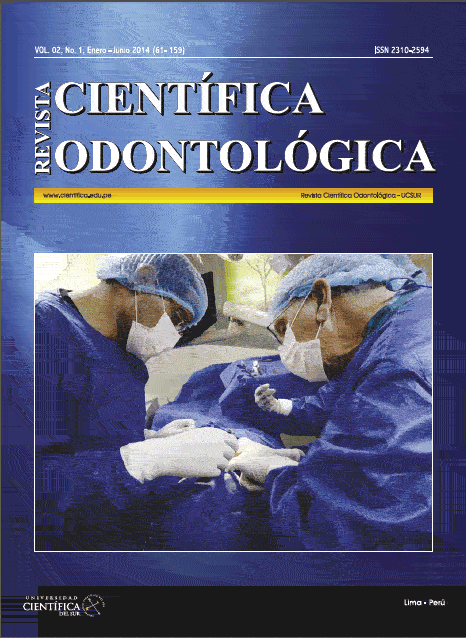Resistencia de unión de una resina autoadhesiva usando diferentes protocolos de adhesión sobre esmalte bovino
DOI:
https://doi.org/10.21142/2523-2754-0201-2014-%25pPalabras clave:
Resistencia, Resinas, Esmalte Dental, Bovinos, Recubrimiento Dental AdhesivoResumen
OBJETIVO: Evaluar la resistencia de unión de una resina fluida autoadhesiva Dyad Flow (DF, Kerr) usando diferentes protocolos de adhesión sobre esmalte bovino al cabo de 24 horas.
MATERIALES Y MÉTODOS: Se utilizaron quince incisivos inferiores bovinos sanos, 5 por cada grupo. Se aplicó DF sobre el esmalte, utilizando un molde de teflón de 8 mm de diámetro interno y 4 mm de alto, usando tres diferentes protocolos: (I) DF (control); (II) ácido fosfórico 37.5% (Gel Etchant, GE, Kerr)+DF y (III) GE/adhesivo (Optibond S, OB, Kerr)+DF. Los especímenes de 1 mm2 de área transversal (n = 30 por grupo) se obtuvieron con una máquina de cortes tipo IsoMet y se almacenaron en agua destilada por 24 horas a 37 °C. La prueba de microtensión se realizó haciendo uso del Microtensile Tester (Bisco). Para el análisis estadístico se utilizó ANOVA y Tukey (p=0.05).
RESULTADOS: La resina Dyad Flow siguiendo las indicaciones del fabricante presentó una resistencia de unión de 23.20 ± 5.97 MPa, no encontrándose diferencias significativas al compararlo con la aplicación previa de ácido fosfórico (26.26 ± 5.5 MPa) y ácido fosfórico más adhesivo (22.70 ± 5.40 MPa). Sin embargo, el protocolo II fue significativamente mayor que el protocolo III (p = 0.043).
CONCLUSIÓN: La resistencia de unión de la resina fluida autoadhesiva Dyad Flow sobre esmalte bovino presentó una conducta adhesiva similar al ser comparada con previo grabado ácido y grabado ácido más adhesivo.
Descargas
Referencias
Gomes MA. Sistemas adhesivos autograbadores en esmalte ventajas e inconvenientes. Av Odontoestomatol. 2004;20(4):193-8.
Andrade AM, Moura SK, Reis A, Loguercio AD, García EJ, Grande RH. Evaluating resinenamel bonds by microshear and microtensile bond strength tests: effects of composite resin. J Appl Oral Sci. 2010;18(6):591-8.
Vichi A, Goracci C, Ferrari M. Clinical study of the self-adhering flowable composite resin Vertise Flow in Class I restorations: six-month follow-up. Universidad Científica del Sur Revista Científica Odontológica. 2014;2:117-126 International Dentistry. 2010;12(1)14-23.
Kerr Sybron Dental Specialtis. [Internet]. Dyad Flow. Resina fluida autodherente. [citado 2 Jul 2012] Disponible en: http://intl.kerrdental.com/cms-filesystem-action?file=/kerrdental-pdf/
dyadflow_ss_spanish_35376_rev1_wip.pdf
Sabbagh J, Souhaid P. Composite Vertise™ Flow; un gran avance en la odontología adhesiva. Clinical Report Kerr. 2010:1-13.
Ahmad I. Compobond: evolution of a new restorative dental material. Industry Report Compobond. 2010;1:20-32.
Perdigao J, Frankerberger R, Rosa BT, Breschi L. New trends in dentin/enamel adhesion. Am J Dent. 2000;13(Spec No):25D-30D.
Lopes GC, Baratieri LN, De Andrada MA, Vieira LC. Present state of the art and future perspectives. Quintessence Int. 2002;33(3):213-24.
Van Landuyt K, Kanamilli P, De Muco J, Peumans M, Lambrechts P, Van Meerbeek B. Bond strength of a mild self-etch adhesive
with and without prior acid-etching. J Dent. 2006;34(1):77-85.
Tay F, Pashley D, King N y col. Aggressiveness of self-etching adhesives on unground enamel. Oper Dent. 2004;29:309-16.
Torii Y, Itou K, Nishitani Y, Ishikawa K, Suzuki K. Effect of phosphoric acid etching prior to self-etching primer application on adhesion of resin composite to enamel and dentin. Am J
Dent. 2002 Oct;15(5):305-8.
Padros J, Monterrubio M, Padros E. Adhesivos Autograbantes. Grabar o No Grabar. RCOE. 2003;8(4).
Bui H, Nguyen TD, Qian X, Tobia D. Bond Strength of a New Self-Adhering Flowable Composite [Internet]. IADR/AADR/CADR 87th
General Session and Exhibition, Miami (April 1-4, 2009); [citado 22 Jun 2012]. Disponible en: http://iadr.confex.com/iadr/2009miami/
webprogram/Paper116942.html
Rengo C, Goracci C, Juloski J. Influence of phosphoric acid etching on microleakage of a self-etch adhesive and a self-adhering
composite. Aust Dent J. 2012 Jun;57(2):220-6.
Vichi A, Margvelashvili M, Goracci C, Papacchini F, Ferrari M. Bonding and sealing ability of a new self-adhering flowable
ARTÍCULO ORIGINAL composite resin in class I restorations. Clin Oral Investig. 2013Jul; 17(6):1497-506.
Poitevin A, De Munck J, Van Ende A. Bonding effectiveness of self-adhesive composites to dentin and enamel. Dent Mater. 2013
Feb;29(2):221-30.
De Munck J, Van Landuyt K, Peumans M. A critical review of the durability of adhesion to tooth tissue: methods and results. J Dent Res. 2005:84:118-32.
Finger WJ, Shao B, Hoffmann M, Endo T, Komatsu M. Does application of phaseseparated self-etching adhesives affect the bond
strength? J Adhes Dent. 2007:9:169-73.
Siegward D. Heintze. Clinical relevance of tests on bond strength, microleakage and marginal adaptation. Dent Mater. 2013 Jan;29(1):59-84.
Van Landuyt KL, Peumans M, De Munck J, Lambrechts P, Van Meerbeek B. Extension of a one-step self-etch adhesive into a multi-step adhesive. Dent Mater. 2006;22(6):533-44.
Poitevin A, De Munck J, Van Landuyt K. Critical analysis of the influence of different parameters on the microtensile bond strength of adhesives to dentin. J Adhes Dent. 2008;10:7–16.
Latta MA, Naughton WT, Scalon ChF. Adhesión de composite a dentina y esmalte utilizando adhesivos auto-grabadores. [Internet]. Artículos Dentsply, Enero 2010; [citado 23 Jun 2012].
Disponible en: http://www.dentsply.es/Noticias/clinica4404.htm.
Nima BG. Fuerza de adhesión in vitro de cinco sistemas adhesivos y un cemento autograbadorautoadhesivo sobre la dentina del canal radicular y coronal superficial [tesis para optar el título de
cirujano dentista]. Lima: Universidad Nacional Mayor de San Marcos; 2006. Universidad Científica del Sur Revista Científica Odontológica. 2014;2:117-126 Recibido: 03 - 12 - 13 Aceptado: 05 - 01 - 14
Autor principal: Teresa Verónica Ulloa Cueva Correspondencia: tvuc@hotmail.com
Scherrer SS, Cesar PF, Swain MV. Direct comparison of the bond strength results of the different test methods: a critical literature
review. Dent Mater. 2010;26:e78–e93.
Poitevin A, De Munck J, Van Landuyt K. Critical analysis of the influence of different parameters on the microtensile bond strength of adhesives to dentin. J Adhes Dent. 2008;10:7–16.
Macchi RL. Materiales Dentales. 3a ed. Buenos Aires: Editorial Panamericana; 2000.
Phrukkanon S, Burrow MF, Tyas MJ. Effect of cross-sectional surface area on bond strengths between resin and dentin. Dent Mater.
;14:120-8.
Soto C, Stanke F, Rioseco M. Diente de bovino, una alternativa a los dientes humanos como sustrato en investigación. Revisión bibliográfica. Rev Fac Odontol Univ Chile. 2000;18(1):19-29.
Schilke R, Lisson JA, Bauss O, Geurtsen W. Comparison of the number and diameter of dentinal tubules in human and bovine dentine
by scanning electron microscopic investigation. Archives of Oral Biology. 2000;45:355–36.
Reis AF, Giannini M, Kavaguchi A, Soares CJ, Line SR. Comparison of microtensile bond strength to enamel and dentin of human, bovine,
and porcine teeth. J Adhes Dent. 2004;6:117–121.
De Munck J, Mine A, Poitevin A, Van Ende A, Vivan Cardoso M, Van Landuyt K y col. Metaanalytical review of parameters involved in
dentin bonding. J Dent Res 2012;91:351-7.
Descargas
Publicado
Número
Sección
Licencia

Este obra está bajo una licencia de Creative Commons Reconocimiento 4.0 Internacional.












